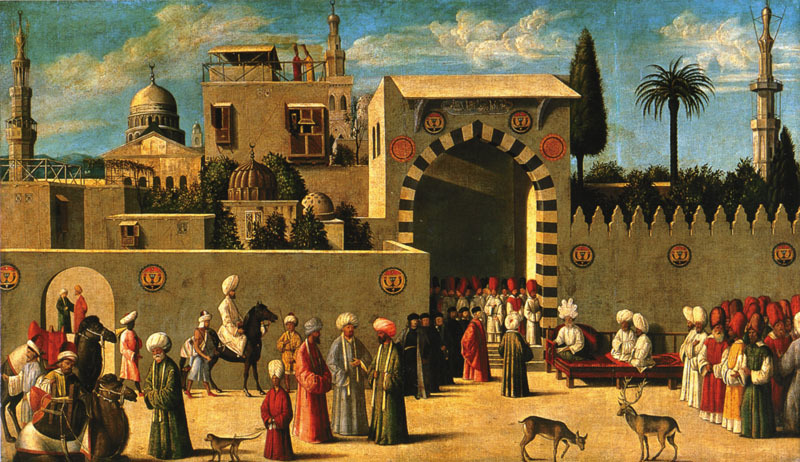Venice and Islam: 828–1797
Gazing up at the walls of the Sala dello Scrutinio in the Doge’s Palace, at the enormous canvases depicting tumultuous scenes of colliding fleets, flashing armour and swords, flying arrows, broken spars, burning and sinking ships, and waters congested with enemy dead and dying, you could be forgiven for thinking that Venetian history was one long sea-battle, with the Serenissima fighting almost single-handed to stem the Islamic tide.
And for that reason this lofty hall is a perfect setting for this exhibition, because so much of what we see in the paintings, art and artefacts on view at floor level (and in the art and architecture throughout the rest of the city) contradicts this image of permanent conflict and the irreconcilable clash of civilisations.
The year 828 is the traditional date given for when two Venetian merchants smuggled the remains of St Mark out of Alexandria and to Venice. At this early time the presence of the Venetians in the Levant was negligible, but in the succeeding centuries they saw off their rivals and established a virtual monopoly on the trade in key commodities between the eastern Mediterranean and the West. Wars with Islamic states occurred, but there were long periods of peace and the flow of trade was seldom seriously disrupted.
As the commerce expanded, Venetian merchants spent extended periods of residence in eastern ports and travelling in the interior. They often adopted local dress and learnt local languages. Venetian dialect became peppered with words of Greek, Arabic and Turkish origin. Many Venetian words, especially but not only maritime and mercantile terms, were absorbed by these languages in turn.
Venice itself underwent a process of orientalisation unparalleled in any other Western city, as this display of more than 150 paintings, prints, carpets, textiles, glass, ceramics, metalwork, carvings, leatherwork and books sumptuously reveals. Luxury goods were rare in Europe in the Middle Ages, but were produced in large quantities in the richer and more technologically advanced Islamic East. Venetian knowledge and appreciation of them were unequalled in Europe, and the city’s inhabitants both surrounded themselves with them in their homes and public buildings and sold them on to the rest of Europe.
The making of sophisticated glassware was the first of several techniques that the Venetians imported from the East, transforming its manufacture into a thriving local industry (while remaining heavily dependent on raw soda from the Levant). Raw cotton and silk were imported, from which many of the finished textiles were woven in patterns to suit Islamic tastes, but which became pleasing to Venetian eyes as well, and they were then re-exported to the Orient. Carpets were brought in on a massive scale, and by the second half of the 15th century oriental rugs figure not only in paintings of domestic scenes but also in a host of religious pictures. Many of the pigments that lent such vivid colour to 15th- and 16th-century Venetian canvases were themselves obtained in the Levant.
The narrative paintings of the numerous Venetian ‘scuole’ or charitable confraternities of this period are thronged with figures in oriental dress and abound in Islamic settings. Many scuole members had personal experience of the Levant, and if, for example, the life of St Mark was commissioned, Alexandria was expected to be depicted as the Mamluk city of that day, not as it would have looked in biblical times, a clear sense of location being more important than chronological plausibility. The scuole were also major customers for carpets. A spectacular 16th-century Mamluk one here from the Scuola di San Rocco is over 30 feet long and 12 feet wide.
In the 13th century St Mark’s basilica, whose mosaics already included some of the earliest Venetian oriental scenes, underwent a radical programme of orientalisation, its low-curving Byzantine domes being surmounted by the present bulbous ones, modelled on Mamluk mosques and tombs, and its portals being reconstructed in the latest Moorish style. Subsequent Venetian architects continued to reproduce this new dome shape, Palladio additionally flanking his Redentore church with minaret-like bell towers. Institutional buildings, such as churches and the distinctly Moorish Doge’s Palace itself, inevitably influenced domestic architecture, and that exotic hybrid we now call Venetian Gothic owes as much to Islamic architecture as it does to the gothic architecture of northern Europe.






Comments